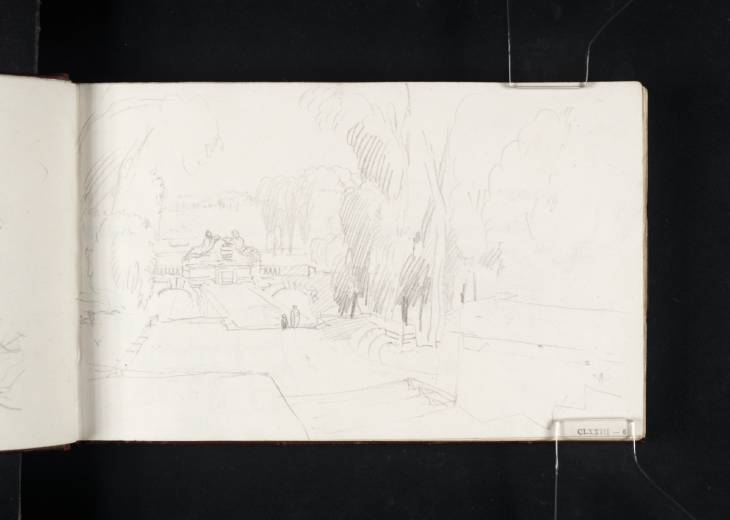Joseph Mallord William Turner The Top of the Grand Cascade, St-Cloud 1819
Image 1 of 2
Joseph Mallord William Turner,
The Top of the Grand Cascade, St-Cloud
1819
Joseph Mallord William Turner 1775–1851
Folio 6 Recto:
The Top of the Grand Cascade, St-Cloud 1819
D14001
Turner Bequest CLXXIII 6
Turner Bequest CLXXIII 6
Pencil on white wove paper, 114 x 185 mm
Stamped in black ‘CLXXIII 6’ bottom right
Accepted by the nation as part of the Turner Bequest 1856
References
1909
A.J. Finberg, A Complete Inventory of the Drawings of the Turner Bequest, London 1909, vol.I, p.504, as ‘?St Cloud’.
1999
Ian Warrell, Turner on the Seine, exhibition catalogue, Tate Gallery, London 1999, pp.18, 225, reproduced p.226 fig.223, as ‘The Junction of the Seine and the Marne: statues at the top of the Grand Cascade, St-Cloud’.
From the centre of Paris, Turner followed the River Seine south-west to the suburbs of Sèvres and St-Cloud and this short detour gave rise to a series of sketches, see folios 5, 6–9, 10 and 11–13 (D13999, D14001–D14006, D14008 and D14010–D14012). He made a number of studies of the two stone bridges that spanned this stretch of the river, the Pont de St-Cloud and the Pont de Sèvres, but the main focus of the expedition was the Château de St-Cloud, a historic royal palace whose former owners had included the Dukes of Orléans, Marie-Antoinette and Napoleon Bonaparte. The château was set in an extensive area of parkland, redesigned during the seventeenth century by André Le Nôtre (1613–1700), and although, rather surprisingly, Turner does not seem to have made any records of the palace on this trip, he did make a number of drawings of features within the garden.
As art historian and former Tate curator Ian Warrell first identified, the subject of this study is the Grand Cascade of St-Cloud, an elaborate seventeenth-century fountain which slopes down towards the river at the eastern perimeter of the park.1 Designed by Antoine Le Pautre (1621–1679), it was built in 1664–5 and still survives today, even though the château itself was destroyed in 1870 during the Franco-Prussian war. Turner’s viewpoint is amidst the wooded parkland above the Haute Cascade (upper cascade) looking east towards an allegorical sculpture group which crowns the two arched, bridge-like structure at the top. Comprised of two figures reclining on urns the statues by Lambert-Sigisbert Adam (1700–1759) represent the junction of the Seine and Marne rivers.2 To the right is a flight of semi-circular stone steps whilst to the left is one end of a long rectangular pond. A general view of the Grand Cascade from the bottom can be found on folio 11 (D14010).
Turner revisited St-Cloud on several occasions and made many further sketches of the château and its gardens, see for example an alternate view of the Grand Cascade within the Paris and Environs sketchbook of 1832 (Tate D24444; Turner Bequest CCLXVII 141a).3 The fountain formed the subject of a watercolour of 1832–3 which was engraved and published within Scott’s Life of Napoleon Buonaparte (Fitzwilliam Museum, Cambridge).4
Nicola Moorby
February 2013
How to cite
Nicola Moorby, ‘The Top of the Grand Cascade, St-Cloud 1819 by Joseph Mallord William Turner’, catalogue entry, February 2013, in David Blayney Brown (ed.), J.M.W. Turner: Sketchbooks, Drawings and Watercolours, Tate Research Publication, August 2013, https://www


